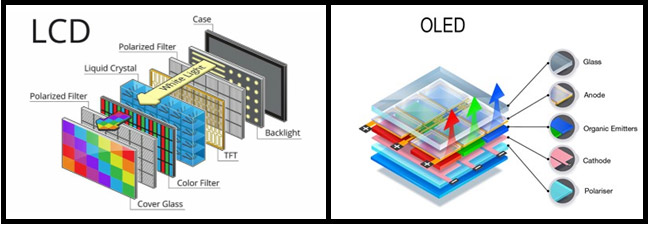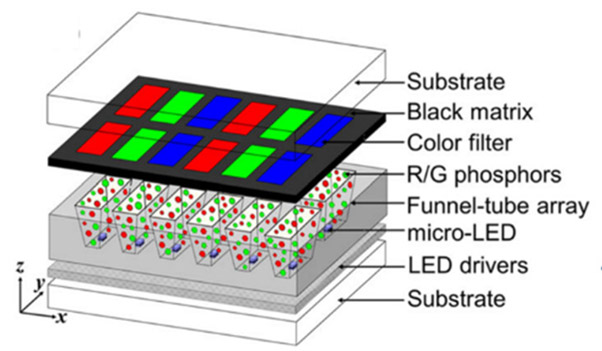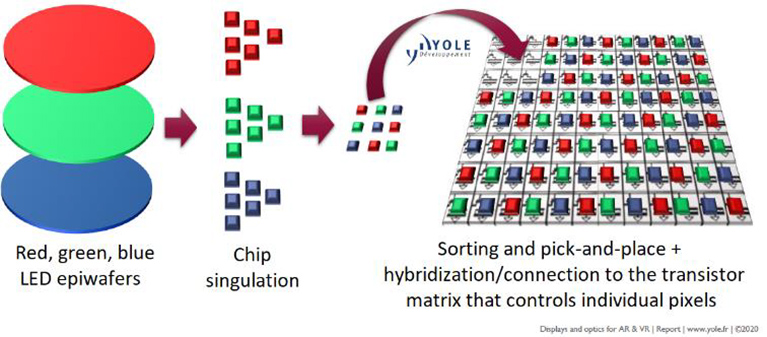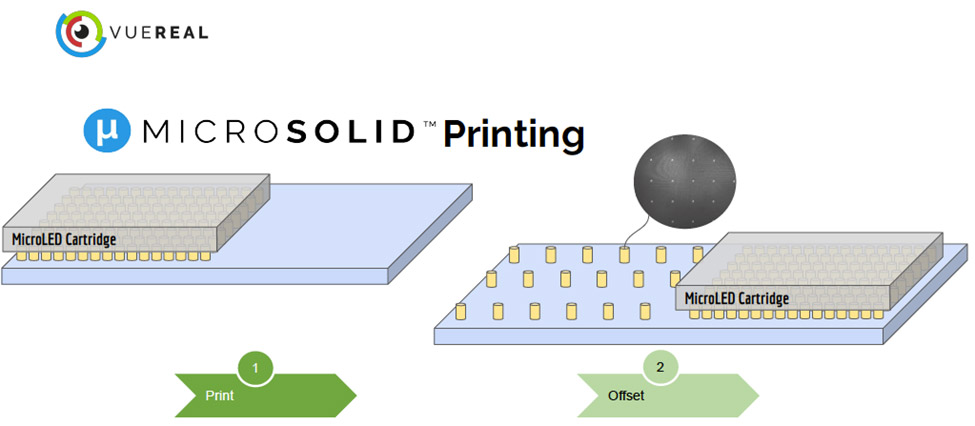Welcome to the Electronic Display Market
Our world is more digital than ever. So much of our everyday lives are now contained on the cloud, accessed through any number of devices ranging from our laptops and tablets to our smart phones, smart watches, and even TVs. It should come as no surprise then that the display industry, representing how humans interact with these devices, was valued at approximately $150-billion in 2021. Market outlook suggests progress has no intention of slowing down either, as the industry is expected to break $177-billion in 2026.
The question is, however, where is this growth expected to come from?
For the past decade or so, much of the market has been occupied by liquid crystal display or LCD and associated technologies. LCD remains the most mature, and therefore lowest cost solution in the display world. In simplified terms, LCD consists of liquid crystal material sandwiched between a backlight and color filters. Once powered, the backlight remains constantly emitting light. The light shines through the liquid crystal, which when manipulated can vary opacity to user specifications. Finally, light propagates through spatially distributed and controlled color filters, which then enables the end visual display to show variations across the RGB spectrum [1].
While a long-time king of the market, current and future applications are pushing LCD to its limit. The backlight-based approach requires constant power, regardless of whether a location of the display is active or not. This is the source of the “truest black” conundrum. When an LCD display shows an all-black background (or black in parts), because it is still backlit, the effect is not as visually true as alternative methods. Visual aesthetics aside, this has significant implications on power consumption and sustainability considerations. Additionally, compared to the ever-progressing rise of computational ability, LCD display performance is also beginning to show its constraints. The configuration has low pixel density (limiting resolution), lower contrast, low switching speed (limiting frames per second), and low mechanical flexibility (not amenable to curved screens). Key applications like augmented reality (AR), next generation heads-up displays (HUDs), automotive displays, smart phones, smart watches, TVs, and computer displays are driving the industry to require higher performance display technologies with reduced power limitations and more robust physical endurance.
In recent years, the apparent alternative to LCD has been the organic light-emitting diode or OLED technology. Instead of relying on a backlight, OLEDs function based on individual diodes, which consist of an organic material that emits light when electric current is applied and is then optically manipulated for contrast. The method has shown significant advantages in power consumption, as energy is only applied to each OLED individually as needed. The organic material can be a polymer or other malleable material, which has allowed for the invention of flexible and curved screens [2].
While showing strong promise in many applications and having done wonders to push the display industry forward, OLED has two key technical constraints, which limit overall viability and lifetime: (1) the organic chemistry involved is sensitive to degradation by oxygen, heat, UV, and must be encapsulated and protected, and (2) brightness is consistently low and not well suited for viewing in already bright environments. For implementations such as in automotive or exterior lighting, OLED solutions currently aren’t suited, both from a performance standpoint — due to insufficient brightness — and a survivability perspective, as the OLEDs tend to degrade over time. Looking to the future of electronic displays, the progress of current technology paints a picture of exactly what is needed — a solution which can bring the same brightness, mechanical durability, and low cost of LCD, while providing the same (or better) energy efficiency and resolution of OLED.
Figure 1. Structural layers of both LCD and OLED display configurations [1,2].
The Advent of microLED
In 2000, Professors Hongxing Jiang and Jingyu Lin (now of Texas Tech University) invented micro-sized light-emitting diodes (LEDs), or now simply called microLED technology [3]. Having since matured from academic experiment to demonstrated systems, microLED is considered, by many, to be the holy grail of display technology. Like standard LED systems [4], microLEDs are semiconducting light sources, which emit when subjected to current flow. The key difference, as is evident by the name, is that microLEDs can range from 2 to 40 microns in size — about the size of a white blood cell! For a microLED display, each pixel contains a configuration of red, green, and blue (RGB) microLED subpixels, which then light up in controlled combination to provide the spectrum of colors necessary. With each subpixel being individually controllable, power is only needed for pixels actively in use, significantly reducing energy consumption when compared to LCD devices, while providing performance (in particular brightness) as good or better than OLED.
Figure 2. Layers of a microLED display [5].
In fact, microLED shows the promise to be able to overcome almost all of the technical challenges associated with previous display approaches. In addition to brightness, the incredibly small-length scale allows for greater pixel density than any other alternative, which means improved resolution. Displays are capable of true black (unlike LCD), as there is no constant backlight, and with no encapsulation from oxygen necessary, its environmental durability is unmatched. MicroLEDs can even be made into flexible and curved screens. They also are significantly faster in terms of changing their on/off state, operating as an electronic (semi-conductor) switch instead of having to wait on the response of a chemical reaction (organic materials). In the future, this could enable significantly higher frames per second.
Given such robust potential, microLED is a prime candidate solution for many upcoming applications currently maturing in their own right. Augmented reality (AR) tech will require extremely high resolution and high brightness if images are to be projected onto variable real-world backgrounds. The combination of microLED’s unparalleled pixel density without sacrificing performance makes it the only technology that can deliver on both design demands and facilitate the immersive experience the AR industry is promising. Due to its superior brightness and contrast, it is potentially the only approach perfectly suited for automotive head up displays (HUDs). Even more critically, microLED has the conformability (curved screens) and durability to have tractable lifetime and survivability in extremely dynamic automotive environments. The case becomes even more compelling in the context of electric vehicles (EVs). When electric power is directly related to the distance your vehicle can traverse, every bit of energy used is critical — and every watt that displays use of your battery is one that doesn’t get you down the road. MicroLED has the lowest power consumption of either alternative (OLED or LCD) and could be a key contributor to improving range in EV platforms.
Challenges & the VueReal Solution
With such meteoric promise, the question then becomes what stands in the way of microLED delivering on all its potential. The answer lies in the manufacturing process itself, which relies on two key underpinning steps — (1) manufacturing of each microLED, and (2) transferring the microLEDs onto the display backplane. Creating the microLEDs themselves is actually a more-mature process derived from traditional LED systems, which has since been scaled over the course of decades. However, the second step remains technically challenging.
Figure 3. Process of creating a microLED display [6].
The microLEDs themselves cannot be manufactured on the display backplane. So every micron-sized microLED must be moved and precisely placed in the right location to create the sub pixels and pixels, which, it turns out, is not very easy. For example, in a 1920 x 1080-pixel screen with RGB pixels, there are over 6-million microLED chips that need to be transferred and precision placed.
Up until now, this constraint (aptly called mass transfer) has limited acceleration and commercialization of the microLED industry as a whole. An ideal solution must be able to deliver on several metrics to enable meaningful mass transfer — precision placement of each microLED, a high throughput of microLEDs transferred in each step, a high yield in total number of working microLEDs after the transfer, and — of course — all at a competitively low cost.
This is where VueReal, the trendsetting microLED startup, has been able to innovate and change the game entirely. They have created a microprinting process, which enables them to carry scalable amounts of microLED chips on individual transfer cartridges, and then deposit individual or sets of chips at a given location with complete control. Imagine thousands of microLEDs on a cartridge printhead that is then aligned onto a backplane, where only the target set of chips are released and bonded to the backplane, and then the printhead is free to continue to the next area and release the next set. Instead of precision placing one microLED at a time, or many (hundreds) but with poor accuracy and placement, VueReal’s technology can cover over 10,000 sq-cm of area per hour per printhead with 99.999% successful placement and with ±1 micron precision. That’s at the top of the market precision at 100x the speed — especially when multiple printheads are used synergistically. In short: high yield, high throughput, and high precision.
Figure 4. A schematic of VueReal’s microprinting process [7].
As VueReal has matured this tech, they are also bringing down cost. On top of being streamlined for rapid, precision, and efficient chip transfer, printheads are compatible with already existing machines in the manufacturing industry (standardized by ASM, SET, etc.), meaning reduced capital expenditure and the ability for expedited adoption to standard assembly lines.
Not only do microLEDs require the lowest amount of operating power, but with this microprinting approach, manufacturing them does as well. VueReal’s process consumes 15% of the energy required by OLED. No waste is created, and no toxic or excess materials are used. Across the board, the approach is a huge win for sustainability — less materials, less power, but more performance. VueReal has broken the barrier holding microLED back from market acceleration, and by solving mass transfer has made manufacturing not just feasible, but tractable and ready for commercialization. In fact, they already are. As announced in Q4 of 2021, they were already working with OEMs and other customers to provide custom-display solutions [8].
Alignment with TDK Ventures
In exploring the electronic display market space, it quickly became clear to our team that the future was microLEDs, and the key to unlocking their potential was solving the mass transfer problem. In getting to know the VueReal team, we found their technology to be exactly the solution the industry has been looking for ever since the invention of microLED 20 years ago. It’s hard to overstate their potential, and they’ve already achieved impressive success maturing their approach and gaining significant market traction. From a strategic perspective, we immediately saw their value in our greater vision. Not only can they enable and be a megatrend driver in digital transformation (which almost goes without saying), but also they are game changers in energy transformation (EVs, reduction of power consumption, etc.) as well as the environmental space (no toxic waste generated, and significantly fewer resources required). VueReal is a perfect match for who we at TDK Ventures seek to serve as impact scalers. We look forward to bringing all of the TDK Goodness we can to making our mutual vision for a better, brighter future for all of humanity come to fruition.
In closing, as the entire TDK Ventures team aspires to be consistent with our CODE of conduct and values, I hope to leave you with complete transparency as to why we made our investment decision by walking through our investment criteria:
1. Does VueReal unlock meaningful megatrends in digital, energy, environmental transition? The answer is a resounding YES, across the board.
- Does VueReal provide venture like returns?YES. The display and microLED markets are large and growing with promising CAGR over the next 5 to 10 years.
- Does VueReal provide strategic value?Absolutely. We have strong synergy with our component and equipment business, and more importantly it pushes our greater mission for a better tomorrow for all.
- Is VueReal sustainable?YES. Power consumption for displays will be significantly reduced and the manufacturing process is exceptionally green.
References
[1] Luo, C. (2021, February 19). LED or LCD: Which one do you really need? Linsn LED.
[3] Lin, J. Y., & Jiang, H. X. (2020). Development of microLED. Applied Physics Letters, 116(10), 100502.
[4] Lenk, R., & Lenk, C. (2016). Practical Introduction to LEDs.
[5] Wu, Y., Ma, J., Su, P., Zhang, L., & Xia, B. (2020). Full-color realization of micro-LED displays. Nanomaterials, 10(12), 2482.
[7] Communications with VueReal (2020)






